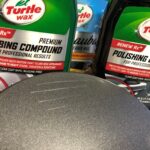Maintaining your car’s cleanliness goes beyond aesthetics; it’s about preserving its condition and value. Regularly washing your car provides an opportunity to inspect for any damage, like chips or scratches, while ensuring dirt and grime are gently removed. However, with various car washing options available, deciding on the best approach can be confusing. Let’s explore different methods to help you determine what you should use to wash your car effectively.
One popular choice is automated car washes, offering a quick and convenient way to freshen up your vehicle, especially during winter to remove road salt. These washes come in two main types: brush and touchless. Brush washes, while common, can sometimes be harsh on your car’s paint. The rotating brushes can trap dirt and grit from previous vehicles, potentially causing swirl marks or scratches. They can also damage loose components like wipers or trim.
Alt: Car entering an automated car wash tunnel.
If you opt for an automated wash, touchless car washes are generally considered a safer alternative. These use high-pressure water and detergents to clean your car without physical contact. The trade-off is that touchless washes might not always achieve the deepest clean, especially for heavily soiled vehicles.
Self-service car washes, often referred to as pay-and-spray car washes, offer a middle ground. These facilities provide a high-pressure spray gun that you control, allowing you to wash your car yourself. They can be more affordable than automated washes and give you greater control over the cleaning process. When using a pay-and-spray, be mindful of the high-pressure nozzle; avoid aiming it directly at delicate trim or getting too close to the paint to prevent damage.
Alt: Person using a high-pressure water gun at a self-service car wash bay.
For a more thorough clean, consider hand-wash car services. Professional hand car washes often excel at reaching areas that machines miss, such as door jambs and intricate trim. The key is to ensure they use clean, soft cloths and quality car soap to avoid scratching your car’s finish. While tempting, resist add-on services like dashboard shining or tire treatments, as they are often unnecessary.
Alt: Car being hand washed with soap and a sponge by a person.
For the ultimate car care experience, especially after winter, investing in a professional car detailing service is highly recommended. Detailing goes beyond a standard wash, providing a deep clean of both the interior and exterior. Detailers possess the expertise and tools to remove ingrained dirt, road grime, and even minor scratches that regular washing can’t address. While costing upwards of $200, detailing can revitalize your car’s appearance. Many detailers offer mobile services for added convenience, and may also provide additional services like polishing, waxing, and headlight restoration.
As Mike Crossen, lead automotive technician at Consumer Reports, points out, “Professional detailing is underrated. Detailers can remove some scuffs and scratches the average owner cannot because they have the tools and experience—and that ability is what you’re paying for.” He likens car care to dental hygiene, emphasizing that regular professional cleaning complements routine maintenance, ensuring your car remains in top condition.
In conclusion, the best method to wash your car depends on your needs, budget, and desired level of cleanliness. For convenience and basic cleaning, touchless automated washes or pay-and-spray are suitable. For a more meticulous clean, hand-wash services are a good option. And for comprehensive restoration and protection, professional detailing offers the highest level of car care. Choosing the right method and using appropriate car washing products will keep your car looking its best and protect its finish for years to come.

